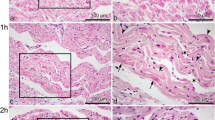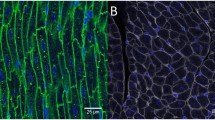Summary
The spatiotemporal distribution of the immunoreactivity of monoclonal antibody HNK-1 was investigated immunohistochemically in normal and bis-diamine-induced malformed rat embryonic hearts using three-dimensional reconstruction with computer graphics. First recognized in the primitive heart 11.5 days after conception, HNK-1 immunoreactivity was distributed in the atrio-ventricular and bulbo-ventricular junctional areas with incomplete ring-like appearance in the early embryonic stages. In the late embryonic stages the immunoreactive sites were rearranged and localized in the sites topographically corresponding to almost the entire pathway of the conduction system, including the three major internodal tracts connecting the right sinoatrial node and atrioventricular node. Immunoreactivity gradually decreased after the completion of the conduction system, and only a faint reactivity in the atrio-ventricular node region remained in the new-born heart. These results indicate that HNK-1 is expressed temporarily in the pathways corresponding to the conduction system during the development of the heart. In bis-(dichloro-acethyl)-octamethylen-diamine (bis-diamine)-induced malformed hearts, localization of HNK-1 immunoreactivity was not remarkably altered in the early embryonic heart. In the late embryo, immunoreactive sites in the sino-atrial node region and atrio-ventricular node region deviated dorsocaudally with the poorly developed internodal tracts, and abnormal distribution was observed in the bilateral atria. We consider that these abnormalities may occur in conjunction with abnormal morphological development such as insufficient absorption of the sinus venosus.
Similar content being viewed by others
References
Abo T, Balch CM (1981) A differentiation antigen of human NK and K cells identified by a monoclonal antibody (HNK-1). J Immunol 127:1024–1029
Anderson RH, Becker AE, Wenink ACG, Janse MJ (1976) The development of the cardiac specialized tissue. In: Wellens HJJ, Lie KI, Janse MJ (eds) The conduction system of the heart. Nijhoff, The Hague, pp 3–28
Benninghof A (1923) Über die Beziehungen des Reizleitungssys-tems und der Papillarmuskeln zu der Konturfasern des Herz-schlauses. Anat Anz 57:185. Cited in: Wellens HJJ, Lie KI, Janse MJ (eds) The conduction system of the heart. Nijhoff, The Hague
Filogamo G, Corvetti G, Daneo LS (1990) Differentiation of cardiac conduction cells from the neural crest. J Auton Nerv Syst 30:S55-S58
Gorza L, Schiaffino S, Vitadello M (1988) Heart conduction system: neural crest derivative? Brain Res 457:360–366
Gorza L, Vitadello M (1989) Distribution of conduction system fibers in the developing and adult rabbit heart revealed by an antineurofilament antibody. Circ Res 65:360–369
Hsu SM, Raine L, Fanger H (1981) Use of Avidin-Biotin-peroxi-dase complex (ABC) in immunoperoxidase techniques. J Histo-chem Cytochem 29:577–580
Ikeda T, Iwasaki K, Shimokawa I, Sakai H, Ito H, Matsuo T (1990) Leu-7 immunoreactivity in human and rat embryonic hearts, with special reference to the development of the conduction tissue. Anat Embryol 182:553–562
Kawamoto K (1984) Morphological study on the cardiovascular anomalies and the facial anomalies induced by bis-diamine in rats. (in Japanese with English abstract) Nagasaki Med J 59:86–105
Keilhauer G, Faissner A, Shachner M (1985) Differentiation inhibition of neuron-neuron, neuron-astrocyte and astrocyte-astro-cyte adhesion by L1, L2 and N-CAM antibody. Nature 316:728–730
Kirby ML, Stewart DE (1983) Neural crest origin of cardiac ganglion cells in the chick embryo: identification and extirpation. Dev Biol 97:433–443
Künemund V, Jungalwala DB, Fischer G, Chou DKH, Keilhauer G, Schachner M (1988) The L2/HNK-1 carbohydrate of neural cell adhesion molecules is involved in cell interactions. J Cell Biol 106:213–223
Lammers WH, Kortschot A, Los JA, Moorman AFM (1987) Ace-tylcholinesterase in prenatal rat heart: a marker for the early development of the cardiac conductive tissue? Anat Rec 217:361–370
McGarry RC, Helfand SL, Quarles RH, Roder JC (1983) Recognition of myelin-associated glycoprotein by the monoclonal antibody HNK-1. Nature 306:376–378
Okishima T, Takamura K, Matsuoka Y, Ohdo S, Hayakawa K (1990) Distribution of cranial neural crest cells in the chick embryonic heart. Participation in the heart conduction system. (in Japanese with English abstract) Igaku no Ayumi 154:607–608
Sanders E, Moorman FM, Los JA (1984) The local expression of adult chicken heart myosins during development. 1. The three day embryonic chicken heart. Anat Embryol 169:185–191
Sanders E, De Groot IJM, Geert WJC, de Jong F, van Horssen AA, Los JA, Moorman FM (1986) The local expression of adult chicken heart myosins during development. 2. Ventricular conducting tissue. Anat Embryol 174:183–193
Sissman NJ (1970) Developmental landmarks in cardiac morphogenesis: comparative chronology. Am J Cardiol 25:141–148
Sumida H, Akimoto N, Nakamura H (1989) Distribution of the neural crest cells in the heart of birds: a three dimensional analysis. Anat Embryol 180:29–35
Taleporos P, Salgo MP, Oster G (1978) Teratogenic action of a bis (dichloroacethyl) diamine on rats: patterns of malformations produced in high incidence at time-limited periods of development. Teratology 18:5–15
Tasaka H, Takenaka H, Okamoto N, Onitsuka T, Koga Y, Hama-da M (1991) Abnormal development of cardiovascular systems in rat embryos treated with bisdiamine. Teratology 43:191–200
Tucker GC, Aoyama H, Lipinski M, Tursz T, Thiery JP (1984) Identical reactivity of monoclonal antibodies HNK-1 and NC-1: conservation in vertebrates on cells derived from the neural primordium and on some leukocytes. Cell Differ 14:223–230
Wenink AGC (1976) Development of human cardiac conducting system. J Anat 121:617–631
Wensing CJG (1965) Evidence for neurogenic conduction in the mammalian heart. Nature 207:1375–1377
Author information
Authors and Affiliations
Rights and permissions
About this article
Cite this article
Ito, H., Iwasaki, K., Ikeda, T. et al. HNK-1 expression pattern in normal and bis-diamine induced malformed developing rat heart: three dimensional reconstruction analysis using computer graphics. Anat Embryol 186, 327–334 (1992). https://doi.org/10.1007/BF00185981
Accepted:
Issue Date:
DOI: https://doi.org/10.1007/BF00185981




